Passing peak inflation risk
While we’ve made no changes to the cautious but constructive recommended tactical asset allocation adopted in December, we highlight a number of positive developments. Early 2023 has revealed clearer signs we are passing the peak in inflation and central bank hawkishness, while China’s accelerated re-opening and Europe’s warmer-than-expected winter have both improved the macro outlook. For equities, we remain neutral, highlighting the risk of near-term weakness, while encouraging portfolio rebalancing where equity allocations have drifted above their tactical targets.
“December’s US inflation data was another example ... that is, another demonstration that we have had peak inflation and, with that, peak Fed hawkishness.”
- Longview Economics, January 2023
2023 has started with less surprises than 2022
This time last year, virtually all 2022 outlook documents were struggling for relevance, damaged by unanticipated January events. The US Federal reserve (Fed), in its 5 January minutes, had signalled imminent near-term rate hikes, previously slated for much later in the year. And by late January, Russian troops were amassing on Ukraine’s border (albeit most geo-political strategists at the time viewed an actual incursion as unlikely).
As the end of the first quarter approached, hopes of a ‘soft landing’ for growth as post-pandemic inflation peaked were already giving way to the reality that sharply higher energy prices and more rapidly rising rates were on course to deliver a stagflation-like shock for 2022, with inflation and rates sharply higher and growth (potentially) sharply lower.
The unfolding global spike in energy costs would, together with the now increasingly obvious over-stimulatory monetary and fiscal policy through 2021, render the task of slowing growth (to ease inflation risks) a challenge. This is despite the seemingly unending and larger-than-expected monthly rate hikes across most economies.
“Participants concurred that the Committee had made significant progress over the past year in moving toward a sufficiently restrictive stance of monetary policy."
- Fed minutes for December 2022, released 4 January 2023
So far, key aspects of our 2023 outlook have increasingly come into view
As 2023 gets under way and the end of January approaches, the broad gambit of most macro outlooks appears intact, at least as much as it ever does. Indeed, our own macro views, largely unchanged since mid-last year, have also weathered the festive season relatively well. Inflation appears to be passing its peak, central banks appear on the cusp of a pause from raising rates in Q1, and geo-politics have a touch of calm, with China taking a more inclusive tone at January’s World Economic Forum in Davos.
Indeed, this year’s January Fed minutes—while still noting inflation remains too high and rates have further to rise—recognised risks in both directions. While there is a risk that policy may end up being insufficiently tight, the Fed is now also balancing this against the risk, for the first time, that “the lagged cumulative effect of policy tightening could end up being more restrictive than necessary”. Other central banks are raising similar concerns.
Global inflation shows signs of passing its peak
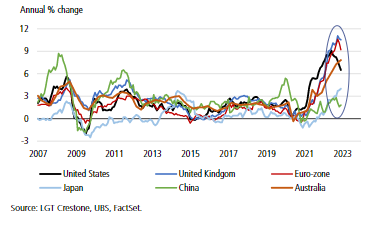
Inflation has also started to come down in the UK and Europe, several months behind the pace of improvement in the US.
Inflation has also started to fall in the UK and Europe, several months behind the pace of improvement in the US. As the chart above shows, US (headline) inflation has eased from 9.1% in June to 6.5% in December. European inflation has eased from 10.6% to 9.2%, while in the UK, it has fallen more modestly from 11.1% to 10.5%.
While Europe and UK central banks retain a hawkish tone, the likely ongoing downward trend in inflation still argues for a pause in policy tightening soon. Even Australia’s Federal Treasurer Chalmers is hoping that this month’s higher-than-expected rise in Australia’s Q4 inflation to 7.8% (its highest since early 1990) will be the peak, allowing the Reserve Bank of Australia (RBA) to pause its rate rising cycle at 3.35% after a likely February hike. The table below shows that central bank rate expectations (from UBS and CBA) are nearing their peak, likely to pause around Q1, before only tentatively beginning an easing cycle late this year. This follows the sharp rate hikes through 2022 (also shown in the table).
Europe has been very successful in filling its gas storages in recent months to well above five-year averages. According to UBS, current levels of 83% are almost 15 percentage points above the 70% five-year average.
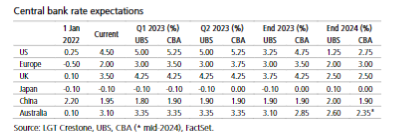
Early 2023 has also delivered two further positive developments that strengthen the case for a ‘soft-ish’ landing for the global economy over the coming year, rather than a deep global recession, that had has had favour at times through 2022.
- Firstly, China has been rapidly accelerating its easing of COVID-19 restrictions that have, among other things, negatively impacted global supply chains and driven much weaker China growth. From late last year, mobility restrictions have eased, local lockdowns have ended, and vaccinations have ramped up. By early January, borders had re-opened for inbound and outbound travel. Global supply pressures have eased.
- Secondly, a warmer-than-expected European winter has underpinned a more positive outlook. Europe has been very successful in filling its gas storages in recent months to well above five-year averages. According to UBS, current levels of 83% are almost 15 percentage points above the 70% five-year average. The milder weather has also unleashed a wave of cuts to energy price forecasts, a contrast to this time last year.
If ongoing falls in inflation encourage a pause in hikes before growth momentum is dashed, then the risk of a softer landing for markets and economies is probably higher than it was when we exited 2022 ... Yet, history still lands firmly on the side of a worsening economic backdrop during 2023.
2023 - Worse macro still the right call
In the 1980s and 1990s, getting inflation under control proved difficult for central banks. It required a huge increase in the so-called ‘sacrifice ratio’—an economic metric of how much unemployment needs to rise (or how much output needs to be lost) to get inflation down. Unemployment rose from 6% to 11% in the US in the 1980s and did broadly the same in Australia in the 1990s, as both countries sought target inflation closer to 2%.
Relative to a few months ago, it appears that the extent of ‘sacrifice’ needed in 2023 could be lower than previously feared. If ongoing falls in inflation can encourage a pause in hikes before still resilient economic grow the momentum is dashed, then the risk of a softer landing for both economies and markets is probably higher than it was when we exited 2022.
Yet, history lands firmly on the side of a worsening economic backdrop during 2023. The full weight of rapidly rising interest costs is yet to be felt by households and businesses (albeit housing markets have been showing clear weakness). It is likely that a level of sacrifice (i.e. some rise in unemployment both here and offshore) will be needed, if only to give central banks confidence that inflation is on a sustained path back to normal.
Still, recent positive developments have led to some modest upgrades to the global economic outlook. Late last year, the Organisation for Economic Cooperation and Development (OECD) cut its 2023 forecast from 2.8% to 2.2%—a near-recessionary outlook after a likely 3.0% rise in 2022.
This year, CBA has lifted its outlook from 1.8% to 2.0% on a stronger China and Europe outlook, rising to 2.6% in 2024. UBS sees a similar pace of 2.2% (was 2.1%) for 2023, rising to 2.7% in 2024. UBS has also raised its China forecast from 4.5% to 4.9% and flagged upside risks to its European outlook.
If ongoing falls in inflation encourage a pause in hikes before growth momentum is dashed, then the risk of a softer landing for markets and economies is probably higher than it was when we exited 2022 ... Yet, history still lands firmly on the side of a worsening economic backdrop during 2023.
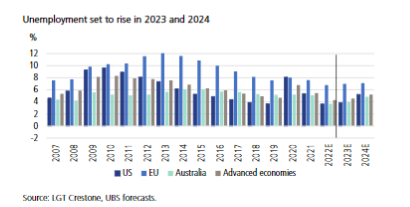
While far from certain, developments as we enter 2023 suggest a softer landing is now more plausible. And while markets are unlikely to be great, there’s now some chance they may be better as we move through 2023.
2023—Better (but not great) markets still the right call
For markets, despite a likely poor macro backdrop, there’s every chance that a steadier rate environment proves somewhat of a panacea. Yes, current earnings expectations remain too high and a headwind to returns (as discussed below). And the downside of a softer economic landing is that central banks may pause their hikes but are less likely to pivot to cuts (reflected in the only modest rate cuts at the end of this year in the table above).
Still, while far from certain, developments as we enter 2023 suggest a softer landing is now more plausible. And while markets are unlikely to be great, there’s now at least some chance they may be better as we move through 2023.
So, as we enter 2023, we maintain our relatively defensive (but not bearish) portfolio positioning that we’ve maintained for much of H2 2022. This involved resisting the temptation to move underweight equities from mid-year as the market bottomed, while moving progressively more in favour of fixed income through the year as central banks lifted interest rates. In our 2023 outlook, we tilted our view somewhat more constructively, and most of those decisions have added value.
- Cash—We remain UNDERWEIGHT, a position adopted in December last year. This was to reflect an improving investment outlook and a more favourable view toward fixed income returns for 2023, as well as markets generally for 2023.
- Fixed income—We remain OVERWEIGHT, recently adding to credit. We maintain our current overweight to government bonds, given our view that we are passing the peak in inflation and central bank hawkishness. We recently moved overweight investment grade credit. While we expect a default cycle and that credit spreads may widen, we see investors as now being adequately compensated through elevated yields.
- Equities—Still NEUTRAL. In December, we remained neutral equities, largely on valuation grounds. However, we reallocated some of our overweight to Australia to emerging markets, given both the recent stellar outperformance of domestic equities and now more compelling emerging market valuations (and positive China news). Both decisions have added significant value between early December and now.
The downside of a softer economic landing is that central banks may pause their hikes, but they are less likely to pivot to cuts.
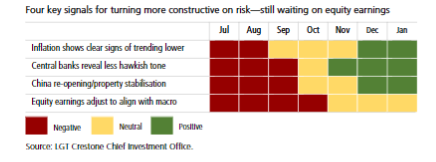
For equities, the extent of the market weakness that will force a central bank pivot (or pause), the magnitude of that pivot and subsequent macro and market recovery remain key uncertainties in early 2023.
Still a challenging backdrop to equities, particularly given recent gains
If history is any guide, a likely material slowing in economic growth, with still elevated inflation and interest rates, is yet to be adequately reflected in equity market earnings. And the US market remains one of the most stretched on these metrics.
As shown in our signals table above, we are yet to fully achieve the four signals required to take an overweight equity view. The final earnings signpost is likely to be clearer by end-February, as US, European and domestic equity reporting seasons wrap up.
For now, we continue to see 2023 as a game of two halves. Firstly, a period of market turbulence amid rate-induced macro weakness that leads to cuts to the earnings outlook. An ongoing re-allocation by market participants from equities to bonds (given bonds are now an attractive asset class) is likely to add to this volatility. The ‘other half’ should be a period of stabilisation as the earnings backdrop steadies and moderately improves.
We expect this initial market weakness will eventually force central banks to pause hiking rates around the end of Q1, and for the most advanced (and aggressive) central bank, the Fed, we expect a so-called ‘pivot’. However, the extent of the market weakness that will force such a central bank pivot, the magnitude of that pivot, and subsequent macro and market recovery remain key uncertainties. It is hard to give a precise answer, but we believe that:
- Equity markets could retest previous lows (or move meaningfully toward them). This would reflect a further decline in corporate earnings and renewed pressure on profit margins, as well as the recognition that rates are higher than at the lows in 2022 (implying lower price/earnings (P/E) ratios now), and the likelihood that interest rates will be, on average, higher than before COVID. This suggests pre-COVID peak P/E ratios are a significant return hurdle in the future.
- The market decline could happen between now and the end of Q1, or soon thereafter, as the market digests a likely lower earnings outlook.
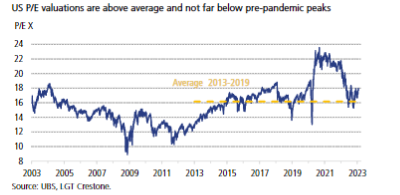
Given the recent rally in equity markets, it is possible that portfolio equity allocations have drifted above their tactical and strategic targets ... where this is meaningful, the opportunity to rebalance portfolios via trimming equity positions near term should be considered.
A final word—Focus on rebalancing
As we enter 2023, developments suggest a softer landing is now more plausible—but it’s certainly far from certain. And while markets are unlikely to be great, there’s now at least some likelihood they may be better than in 2022—and less bad than first feared.
We continue to favour fixed income and alternative investments, given immediate inflation protection, competitive expected returns, and the likelihood that only a steady decline in inflation (rather than collapse) will underpin only modest reductions in rates over the coming year. For equities, we remain constructive (neutral), with a preference for some non-US markets (such as Australia and emerging markets). Upside risks to this view include continued consumer and corporate resilience, or a sharp near-term decline in inflation that could prompt a Fed pivot without significant economic damage (a true soft landing).
Given the recent rally in equity markets, it is possible that portfolio equity allocations have drifted above their tactical and strategic targets. Where this is meaningful, the opportunity to rebalance portfolios via trimming equity positions near term should be considered. This could also be an opportunity to further rebalance within asset classes. For example, within equities, investors can reduce prior high exposures to growth (particularly given the strength in the NASDAQ market) and reduce tracking error through benchmark-aware managers, while ensuring a sufficient exposure to value managers through the cycle.
Learn what LGT Crestone can do for your portfolio
With access to an unrivalled network of strategic partners and specialist investment managers, LGT Crestone offers one of the most comprehensive and global product and service offerings in Australian wealth management.
Click 'CONTACT' to find out more.
1 topic

